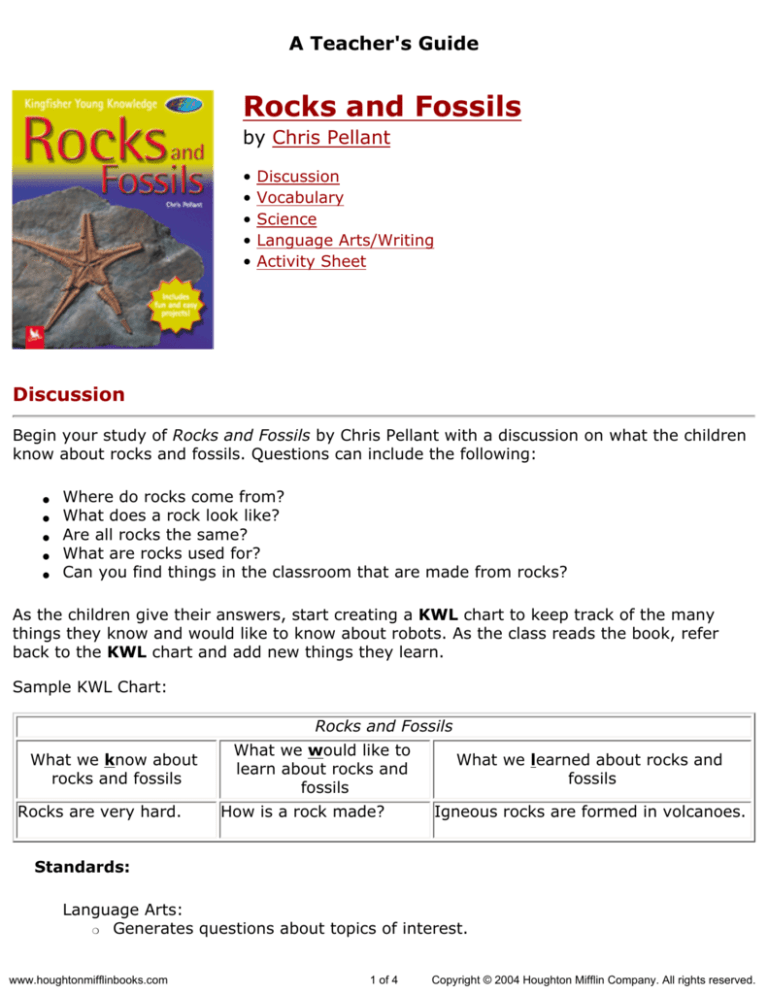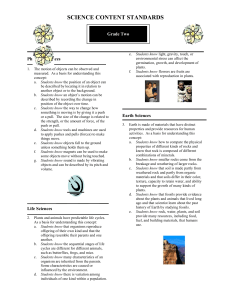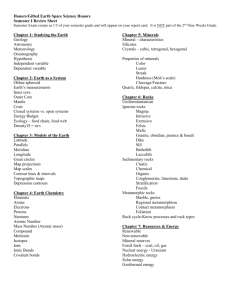
A Teacher's Guide
Rocks and Fossils
by Chris Pellant
•
•
•
•
•
Discussion
Vocabulary
Science
Language Arts/Writing
Activity Sheet
Discussion
Begin your study of Rocks and Fossils by Chris Pellant with a discussion on what the children
know about rocks and fossils. Questions can include the following:
●
●
●
●
●
Where do rocks come from?
What does a rock look like?
Are all rocks the same?
What are rocks used for?
Can you find things in the classroom that are made from rocks?
As the children give their answers, start creating a KWL chart to keep track of the many
things they know and would like to know about robots. As the class reads the book, refer
back to the KWL chart and add new things they learn.
Sample KWL Chart:
Rocks and Fossils
What we know about
rocks and fossils
Rocks are very hard.
What we would like to
learn about rocks and
fossils
How is a rock made?
What we learned about rocks and
fossils
Igneous rocks are formed in volcanoes.
Standards:
Language Arts:
❍
Generates questions about topics of interest.
www.houghtonmifflinbooks.com
1 of 4
Copyright © 2004 Houghton Mifflin Company. All rights reserved.
❍
❍
❍
Uses a variety of sources to gather information.
Makes contributions in class and group discussions.
Relates new information to prior knowledge and experience.
Vocabulary
Highlighted vocabulary words can be found at the bottom of the pages in the book. Here are
additional words from the text that you should focus on:
granite (page 7)
minerals (page 7)
igneous rocks (page 8)
basalt (page 11)
sedimentary rocks (page 12)
limestone (page 14)
metamorphic rocks (page 16)
meteorite (page 24)
fossilization (page 30)
geologist (page 32)
Our suggestions on how to use these words effectively are found on page 2 of the guide.
Standards:
Language Arts/Readings:
❍
Uses word reference materials to determine the meaning and pronunciation of
unknown words.
❍
Uses a variety of context clues to decode unknown words.
Science
A geologist is a scientist who studies rocks by making careful observations. Have your
students be junior geologists.
Materials needed:
●
●
●
●
Collection of different rocks
Large bag
Magnifying glass
Rock worksheet (see the reproducible at the end of the guide)
Procedure:
●
Place the rocks in the bag.
●
Have each child reach into the bag and select a rock.
●
●
The children should observe their rock's shape, size, color, hardness or softness,
texture (smooth, shiny, rough, sharp), and smell.
They should also examine their rock's crystals with the magnifying glass and note the
crystals' size, color, and shape.
www.houghtonmifflinbooks.com
2 of 4
Copyright © 2004 Houghton Mifflin Company. All rights reserved.
●
The observations should be entered on the worksheet.
●
Collect the rocks and place them back in the bag.
●
Pour the rocks onto the table and have the children find their rocks based on their
observations.
Standards:
Science:
❍
Understands the nature of scientific inquiry.
❍
Knows that learning can come from careful observations and simple
experiments.
❍
Keeps a written record of all observations.
❍
Knows the properties of rocks.
❍
Knows that rocks come in many different shapes and sizes.
Language Arts/Writing
After reading Rocks and Fossils, ask the class to imagine that a large oval rock that
resembles the dinosaur eggs in the picture on page 35 was found in the school's playground.
Questions for discussion may include the following:
●
●
●
●
●
●
●
●
●
Could it be a real fossilized dinosaur egg?
How did it get in the school playground?
Should they keep it in the classroom or give it to a museum?
What would happen if a dinosaur hatched out of the egg?
What kind of dinosaur would it be?
How would they take care of it?
What name would they give it?
Would the dinosaur be dangerous or friendly?
What would happen when the dinosaur grows up?
After the discussion, have the class write and illustrate stories called "The Day a Baby
Dinosaur Hatched in Our Class."
Standards:
Language Arts/Writing:
❍
Uses prewriting strategies to plan written work.
❍
Evaluates own and others' writing.
❍
Writes in a variety of forms or genres
❍
Understands elements of character development.
❍
Writes and creates visual art in response to literature.
www.houghtonmifflinbooks.com
3 of 4
Copyright © 2004 Houghton Mifflin Company. All rights reserved.
Activity Sheet
[This is a reproducible]
Rock Worksheet
Picture of my rock
My Observations:
Shape: ________________________________________
Size:________________________________________
Texture:_________________________________
Color:_________________________________
Smell:_______________________________________
Crystals (size and color):___________________________________
Junior geologist: _________________________________
www.houghtonmifflinbooks.com
4 of 4
Copyright © 2004 Houghton Mifflin Company. All rights reserved.








